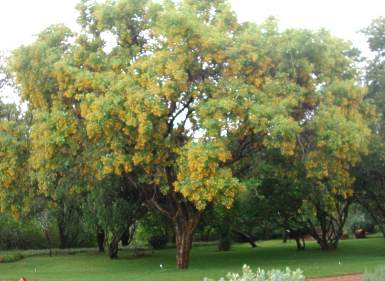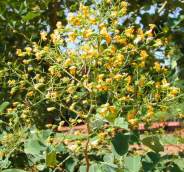Pterocarpus rotundifolius
Pterocarpus rotundifolius (Sond.) Druce
Family: Fabaceae
Common names: Muhataha (Tshivenda), round-leaved bloodwood (Eng.), dopperkiaat (Afr.)
SA Tree No: 237
Introduction
Flowers of Pterocarpus rotundifolius are strongly honey-scented. Bee-keepers like to plant this tree as a good source of nectar and food for bees.

Description
Description
Pterocarpus rotundifolius is a deciduous tree that reaches a height of 10m, but under ideal conditions it can become even bigger. Deep yellow, pea-shaped flowers appear from September to January. During hot, dry weather the flower buds remain closed and they burst into flower only on wet days, lasting two to three days. A flattened pod with one seed matures from November to April. The tree burns very easily in bush fires.

Distribution and habitat
Distribution description
In South Africa it occurs naturally from KwaZulu-Natal in the south, through Swaziland, Mpumalanga, Limpopo (Northern Province) to the northern parts of North-West Province. It is also indigenous to Zimbabwe, Malawi and Zambia. It grows in open bushveld and on rocky hillsides, often forming a colony.
Derivation of name and historical aspects
History
The genus name Pterocarpus means 'winged fruit', and the species name rotundifolius refers to the round leaves. The first "P" in Pterocarpus is silent and the name is pronounced tero-car-pus.

Ecology
Ecology
This tree's scented flowers attract many insects like bees and wasps,which play a vital role in pollination. Ripe fruits are often dispersed by wind. Cattle and game browse the young leaves, and birds use it for nesting. Larvae of the bushveld charaxes butterfly (Charaxesachaemenes achaemenes) live on the leaves.
Uses
Use
It is used as firewood in some parts of Limpopo. In the past it has been used as a general-purpose timber, but the wood is not that durable. It is also a favourite in bee farming as it is a good source of nectar and pollen for honeybees. It is generally a good garden subject. It can be used for providing shade.

Growing Pterocarpus rotundifolius
Grow
In cultivation this tree does best in frost-free areas. In areas where there is frost, give some protection to the trunk in winter in early years. One way to do this is to place rocks which retain the sun's heat around the trunk to protect the tree from night frosts. Once the tree has grown to about 2-3 m, there is no further need to protect it. Summer rain and hot weather are ideal conditions for this tree (20-35°C).

Pterocarpus rotundifolius can be propagated from seed. Seeds must be removed from the pod and soaked in hot water overnight. Discard seeds which have been infested with insect larvae. The next day the seed can be sown in a mixture of sand and sieved compost (2:1). Seedlings should be transplanted in planting bags filled with a sand-based, well-drained growth medium. This is a fast-growing tree, reachinga height of 1 m within a year. It can also be propagated from cuttings taken in early spring. This tree can be used as the background plant or as a free-standing specimen, especially in big gardens.
References
- VENTER, F. & VENTER, J-A. 1996. Making the most of indigenous trees. Briza Publications, Pretoria.
- COATES PALGRAVE, K./MEG. 2002. Trees of southern Africa, edn 3. Struik, Cape Town
- SCHMIDT, E., LÖTTER, M. & McCLELAND, W. 2002. Trees and shrubs of Mpumalanga and Kruger National Park. Jacana, Johannesburg.
Credits
Thompson Mutshinyalo
Pretoria National Botanical Garden
March 2003
Plant Attributes:
Plant Type: Tree
SA Distribution: Gauteng, KwaZulu-Natal, Limpopo, Mpumalanga, North West
Soil type:
Flowering season: Spring, Early Summer
PH:
Flower colour: Yellow
Aspect: Full Sun
Gardening skill: Average
Special Features:
Horticultural zones









Rate this article
Article well written and informative
Rate this plant
Is this an interesting plant?
Login to add your Comment
Back to topNot registered yet? Click here to register.